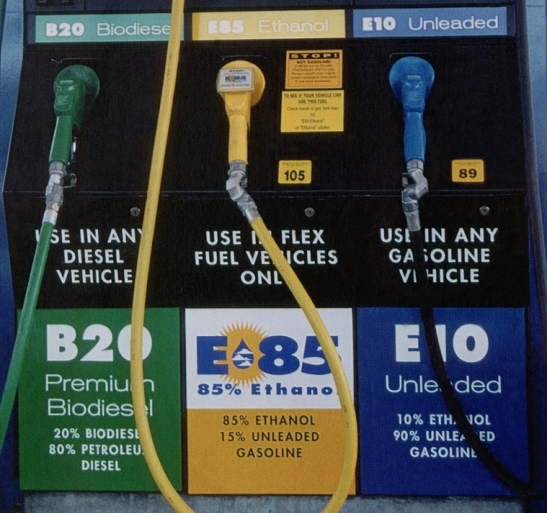Co-Optima Highlights Primary Causes of Misfueling and Mitigation Strategies

Many misfueling mitigation measures such as nozzle colors are not universally standardized. Photo by Charles Bensinger, NREL
A newly released report developed under the NREL-led Co-Optimization of Fuels & Engines (Co-Optima) initiative spotlights the primary causes of vehicle misfueling, resulting issues, and potential strategies for mitigation. Researchers want to avert any risk of drivers filling up with the wrong fuel when new Co-Optima high-performance formulas hit the market. The study, led by Scott Sluder of Oak Ridge National Laboratory (ORNL) with contributions from authors at NREL and Argonne National Laboratory (ANL), drives home the need for more effective misfueling mitigation strategies to ensure the successful commercial rollout of any new fuels.
Today, misfueling mitigation relies largely on dispenser labels, as well as different diameter nozzles for gasoline and diesel. While not universal, diesel and E85 nozzle covers are typically green and yellow, respectively. Vehicle fuel caps and flaps commonly provide additional written and visual cues for fuel selection, but are often ignored by consumers.
Despite these efforts to eliminate confusion at the pump, both intentional and unintentional misfueling remains an issue that can lead to vehicle systems damage. Measures such as nozzle colors are not universally standardized. Fuel price can spur drivers to select an incompatible fuel, despite the risk of potentially expensive mechanic's bills down the road. Drivers may also be unaware of their car's fueling specifications, or may actively want to fuel with higher-ethanol blends for environmental reasons, not realizing they are the wrong choices for their vehicles.
Potential mitigation strategies evaluated by Co-Optima researchers ranged from standard dispenser labeling to establishment of separate islands for different types of fuels and the reintroduction of full-service station attendants. Of all available techniques, electronic misfueling mitigation technologies that enable wireless communication between vehicles and dispensers show the most promise.
The Co-Optima initiative's simultaneous fuels and engines R&D is accelerating the introduction of affordable, scalable, and sustainable fuels and high-efficiency, low-emission vehicle engines. The U.S. Department of Energy's Office of Energy Efficiency & Renewable Energy (EERE) has brought together nine national laboratories—NREL, ORNL, ANL, and Idaho, Lawrence Berkeley, Lawrence Livermore, Los Alamos, Pacific Northwest, and Sandia National Laboratories—to collaborate on this groundbreaking research. Stakeholders from the ethanol, automotive, fueling equipment, and fuel retailer industries, as well as standards development bodies, contributed input to the research.
Learn more about NREL’s sustainable transportation research.
Last Updated May 28, 2025
